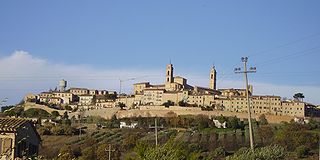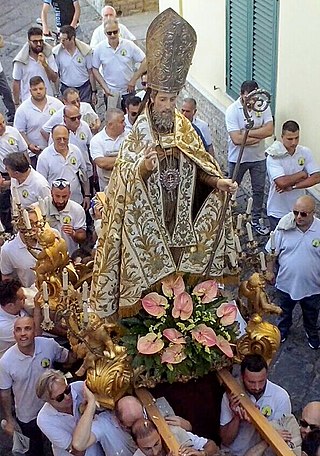
Lucia of Syracuse (283–304), also called Saint Lucia was a Roman Christian martyr who died during the Diocletianic Persecution. She is venerated as a saint in Catholic, Anglican, Lutheran, and Eastern Orthodox Christianity. She is one of eight women explicitly commemorated by Catholics in the Canon of the Mass. Her traditional feast day, known in Europe as Saint Lucy's Day, is observed by Western Christians on 13 December. Lucia of Syracuse was honored in the Middle Ages and remained a well-known saint in early modern England. She is one of the best known virgin martyrs, along with Agatha of Sicily, Agnes of Rome, Cecilia of Rome, and Catherine of Alexandria.

Saint Eustace is revered as a Christian martyr. According to legend, he was martyred in AD 118, at the command of emperor Hadrian. Eustace was a pagan Roman general, who converted to Christianity after he had a vision of the cross while hunting. He lost all his wealth, was separated from his wife and sons, and went into exile in Egypt. Called back to lead the Roman army by emperor Trajan, Eustace was happily reunited with his family and restored to high social standing, but after the death of Trajan, he and his family were martyred under Hadrian for refusing to sacrifice to pagan Roman gods.

Expeditus, also known as Expedite, was said to have been a Roman centurion in Armenia who was martyred around April 303 in what is now Turkey, for converting to Christianity. Considered the patron saint of urgent causes, he is also known as the saint of time; he was commemorated by the Catholic Church on 19 April.

Ortona is a coastal town and municipality of the Province of Chieti in the Italian region of Abruzzo, with some 23,000 inhabitants.
Atella was an ancient Oscan city of Campania, located 20km directly north of Naples.

Saint Acacius, also known as Agathius of Byzantium, Achatius, or Agathonas to Christian tradition, was a Cappadocian Greek centurion of the imperial army, martyred around 304. A church existed in Constantinople associated with Acacius and possibly named after him: the Church of St Acacius.

The province of Fermo is a province in the Marche region of Italy. It was established in 2004 and became operational in 2009. Its administrative centre and provincial capital is the city of Fermo. Other major cities include Porto Sant'Elpidio, Porto San Giorgio, Sant'Elpidio a Mare, and Montegranaro. As of 2017, the province has a population of 174,358 inhabitants and spans an area of 862.77 square kilometres (333.12 sq mi). It contains 40 comuni.

Villemagne-l'Argentière is a commune near Bédarieux in the Hérault department in the Occitanie region in southern France.
Saint Sergius was a Cappadocian monk who was martyred in the persecutions of Diocletian. His feast day is 24 February.

Sant'Elpidio a Mare is a town and comune in the province of Fermo, in the Marche region of Italy.

Civitanova Marche is a comune (municipality) in the Province of Macerata in the Italian region Marche, located about 40 kilometres southeast of Ancona and about 25 km (16 mi) east of Macerata.

Montecosaro is a comune (municipality) in the Province of Macerata in the Italian region Marche, located about 35 kilometres (22 mi) southeast of Ancona and about 15 kilometres (9 mi) east of Macerata.

San Biagio Saracinisco is a comune (municipality) in the Province of Frosinone in the Italian region of Lazio, located about 120 kilometres (75 mi) east of Rome and about 50 kilometres (31 mi) east of Frosinone.
Elpidius is a Roman cognomen.
Eustace of Luxeuil, also known as Eustasius, was the second abbot of Luxeuil from 611. He succeeded his teacher Columbanus, to whom he had been a favorite disciple and monk. He had been the head of the monastic school.
Saint Flavian of Ricina is venerated as a martyr and bishop by the Catholic Church. Tradition holds that he was a bishop of Helvia Ricina (Macerata), during the 3rd century, martyred on November 24. His cult is ancient and widespread in the Marche and Umbria, with many churches and abbeys dedicated to him, but historical information on his life is limited to a few details and traditions.

Eleutherius, also written as Eleutherus, Eleuterus and Eleftherios; sometimes called Liberalis or Liberator, the former transliterations and the latter translations of his and his mother Antia are venerated as Christian saints and martyrs in Greece and Albania.
Sant'Elpidio may refer to a pair of Italian municipalities in the province of Fermo, Marche:

Cappadocian Greeks, also known as Greek Cappadocians or simply Cappadocians, are an ethnic Greek community native to the geographical region of Cappadocia in central-eastern Anatolia; roughly the Nevşehir and Kayseri provinces, and their surroundings, in modern-day Turkey. There had been a continuous Greek presence in Cappadocia since antiquity, and the indigenous populations of Cappadocia, some of whose Indo-European languages may have been closely related to Greek, became entirely Greek-speaking by at least the 5th century.

Elpidius of Atella, or Elpidio in Italian, is a Christian saint. He was a bishop of the city of Atella, from 432 for about 20 years.














